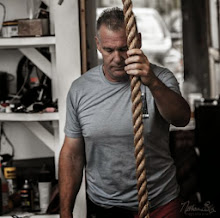First let me say thanks to Jerry B. for pointing out that Phar Lap wasn't a small horse. I think I got this from a picture which may have been Seabiscuit and I got confused.
Never the less--that's how you imply that you're still correct--his power came from his lumbar coiling and his ewe neck contributed to his ability to coil, especially if he had restricted shoulders. Whereas Seabiscuit had a really nicely set on neck and an ability to rise between the shoulders to coil the lumbars.
Lumbar coiling is a very important feature in promoting power in the rear, this is what Dolphins and whales do. While other marine life, fish, don't have this movement. They have lateral bending but not coiling. If we postulate the whales and dophins evolutionarily returned to the oceans from land; then we can postulate that this movement is terrestial and returned with them. So what does this imply? Why was lumbar coiling so important to terrestial life that it adapted it, and that dolphins and whales retained it? I'm still pondering this one.
I first started on this track of analysis in 1995 when I read the proceedings from the "Second Congress on Low Back Pain", my initial interest was applying this to humans--my primary practice--but it quickly mapped over to my work with horses and then with dogs. The key to the coiling--take this with a grain of salt--is the lumbar aponeurosis which is a large fascial "sheet" in the lumbar region of the back. The aponeurosis acts like a spring in that it stores energy from the coiling of the rear end and returns it during the ground phase of the stride. (I'm defining the ground phase as the from the time the foot hits the ground to the time it leaves it, this is obviously part of protraction, or the stance phase.) The aponeurosis is stretched by the coiling as well as the brachiocephalicus stretching the latissimus which attaches into the aporneurosis and the humerus.
By the way it's this aponeurosis that gives Tiger Woods his phenomenal driving ability.
The question is: Why did this adaptation take place in evolution and only in mammals? Was it a part of the legs moving under the body? (amphibian legs are on the outside of the body)
Much more to think about.
By the way, if you look at Seabiscuits pictures you'll see he's really over at the knee on the left fore. I'm writing a two part article about working with one cause of this in Natural Horse Magazine, the first part is the next issue. I'll venture that this didn't slow him down because he was able to dynamically move his Center of Mass towards his rear legs, this is what dressage people call "lightening the forehand".
thanks for reading this.
Sunday, October 5, 2008
Subscribe to:
Post Comments (Atom)




No comments:
Post a Comment